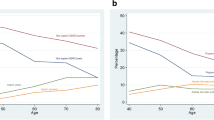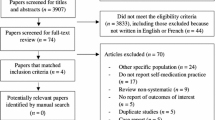Abstract
Background
The relationship between NSAID use and gastrointestinal (GI) symptoms and their treatment in elderly patients is not well defined.
Objectives
To identify the prevalence of specific drug use in elderly outpatients and to identify the relationship between NSAID use and GI disturbances and treatments in elderly subjects treated by their general practitioner (GP).
Settingand participants
The study was carried out by 63 GPs in north-eastern Italy; 3154 elderly subjects were included in the study over a 2-week period.
Design
By using a structured interview, subjects’ medical histories and current medication were identified. In particular, the presence and use pattern (i.e. occasional, ‘acute’ or ‘chronic’) of NSAIDs and/or aspirin (acetylsalicylic acid) were recorded. In all subjects, the presence of upper GI symptoms, i.e. abdominal pain, reflux symptoms and indigestion syndrome, were noted.
Results
The prevalence of drug use was 96.4% (males 96%, females 96.7%). The most prescribed drugs were ACE inhibitors (38%), diuretics (26.7%), NSAIDs and regular-dose aspirin (24.7%), GI drugs (20.6%), and anxiolytics/hypnotics (20.3%). Of 779 subjects who had taken NSAIDs or regular-dose aspirin, 32.9% were ‘chronic’ users, 24.9% were ‘acute’ users and 42.1% occasional users. A significantly higher prevalence of upper GI symptoms was observed in elderly NSAID and low-dose aspirin users compared with non-users (24.9% vs 28% vs 16.6% respectively, p < 0.0001). GI symptoms were reported by 27.6% of ‘chronic’ NSAID users, 22.9% of ‘acute’ users and 24.7% of occasional users. A significantly higher prescription rate for any GI drug was found in NSAID users than in low-dose aspirin users and non-users (24.0% vs 19.6% vs 19.4% respectively, p = 0.007). This difference was mainly because of a higher number of upper GI drugs taken by NSAID users than by low-dose aspirin users and non-users (18.1% vs 16% vs 13.7% respectively, p = 0.004). Multivariate analysis demonstrated that female gender (odds ratio [OR] = 1.32, 95% CI = 1.16–1.44), low-dose aspirin (OR = 1.88, 95% CI = 1.33–2.65), NSAIDs and/or regular-dose aspirin (OR = 1.48, 95% CI = 1.19–1.83) and multiple therapies, i.e. taking more than four drugs per day (OR = 1.42, 95% CI = 1.14–1.77) were risk factors for GI symptoms in elderly outpatients.
Conclusion
NSAIDs and/or aspirin use was very high in this elderly outpatient population. The use of these drugs was significantly associated with a greater number of upper GI symptoms and prescriptions for GI drugs. Educational and clinical strategies need to be implemented in order to reduce the GI impact of NSAID and aspirin use in elderly people.






Similar content being viewed by others
References
Nobili A, Tettamanti M, Frattura L, et al. Drug use by the elderly in Italy. Ann Pharmacother 1997; 31: 416–22
Avorn J, Gurwitz JH. Drug use in the nursing home. Ann Intern Med 1995; 123: 195–204
Nygaard HA, Naik M. Drug use in homes for the aged: a comparison between mentally intact and mentally impaired residents. Aging Clin Exp Res 1999; 11: 186–93
Beyth RJ, Shorr RI. Epidemiology of adverse drug reactions in the elderly by drug class. Drugs Aging 1999; 14: 231–9
Doucet J, Chassagne P, Trivalle C, et al. Drug-drug interactions related to hospital admission in older adults: a prospective study of 1000 patients. J Am Geriatr Soc 1996; 44: 944–8
Mannese CK, Derkx FHM, De Ridder MAJ, et al. Contribution of adverse drug reactions to hospital admission of older patients. Age Ageing 2000; 29: 35–9
Gray SL, Sager M, Lestico MR, et al. Adverse drug events in hospitalized elderly. J Gerontol A Biol Sci Med Sci 1998; 53A: M59–63
Griffin MR, Piper JM, Daugherty JR, et al. Non steroidal antiinflammatory drug use and increased risk for peptic ulcer disease in elderly persons. Ann Intern Med 1991; 114: 257–63
Gabriel SE, Jaakkimainen L, Bombardier C. Risk for serious gastrointestinal complications related to use of nonsteroidal anti-inflammatory drugs: a meta-analysis. Ann Intern Med 1991; 115: 787–96
Langman MJS, Weil J, Wainwright P, et al. Risks of bleeding peptic ulcer associated with individual non-steroidal anti-inflammatory drugs. Lancet 1994; 343: 1075–8
Hawkey CJ, Cullen DJE, Greenwood DC, et al. Prescribing of nonsteroidal anti-inflammatory drugs in general practice: determinants and consequences. Aliment Pharmacol Ther 1997; 11: 293–8
Smalley WE, Griffin MR, Fought RL, et al. Excess costs from gastrointestinal diseases associated with nonsteroidal anti-inflammatory drugs. J Gen Intern Med 1996; 11: 461–9
L’informatore farmaceutico 1998. OEMF International, Milano 1998. Guidelines for ATC-classification. NLN-publication No.16. Uppsala: Nordic Council on Medicines, 1985
La Porte JR, Carnè X, Vidal X, et al. Upper gastrointestinal bleeding in relation to previous use of analgesics and nonsteroidal anti-inflammatory drugs. Lancet 1991; 337: 85–9
Dimenas E, Glise H, Hallerback B, et al. Well-being and gastrointestinal symptoms among patients referred to endoscopy owing to suspected duodenal ulcer. Scand J Gastroentrol 1995; 30: 1046–52
Revicki DA, Wood M, Wiklund I, et al. Reliability and validity of the gastrointestinal symptoms rating scale (GSRS) in patients with gastroesophageal reflux disease. Qual Life Res 1998; 7: 75–83
Beers MH, Ouslander JG, Fingold SF, et al. Inappropriate medication prescribing in skilled-nursing facilities. Ann Intern Med 1992; 117: 684–9
Renner EA, Engle VF, Graney MJ, et al. Prevalence and predictors of regularly scheduled prescription medications of newly admitted nursing home residents. J Am Geriatr Soc 1992; 40: 232–6
Willis P, Claesson CB, Fratiglioni L, et al. Drug use by demented and non-demented elderly people. Age Ageing 1997; 26: 382–91
Walop W, Amos S, Dalziel W, et al. Prescription and nonprescription drug use among high-risk community-dwelling seniors in Ottawa-Carleton. Can J Clin Pharmacol 1999; 6: 93–100
Epidemiology, Statistics and Health Information Unit of the World Health Organization, Regional Office for Europe. Highlights on Health in Italy, September 1998. Available from URL: http://www.who.dk/healthinfo/20020613_l [Accessed 2003 Jun 18]
Chrischilles EA, Lemke JH, Wallace RB, et al. Prevalence and characteristics of multiple analgesic drug use in an elderly study group. J Am Geriatr Soc 1990; 38: 979–84
Singh G, Ramey DR. NSAID induced gastrointestinal complications: the ARAMIS (Arthritis, Rheumatism and Aging Medical Information System) perspective — 1997. J Rheumatol 1998; 25Suppl. 51: 8–16
Talley NJ, Evans JM, Fleming KC, et al. Nonsteroidal antiinflammatory drugs and dyspepsia in the elderly. Dig Dis Sci 1995; 40: 1345–50
Pilotto A, Franceschi M, Leandro G, et al. The effect of Helicobacter pylori infection on NSAID-related gastroduodenal damage in the elderly. Eur J Gastroenterol Hepatol 1997; 9: 951–6
Pilotto A, Leandro G, Di Mario F, et al. Role of Helicobacter pylori infection on upper gastrointestinal bleeding in the elderly: a case-control study. Dig Dis Sci 1997; 42: 586–91
Wolf MM, Lichtenstein DR, Singh G. Gastrointestinal toxicity of nonsteroidal antiinflammatory drugs. N Engl J Med 1999; 340: 1888–99
Pertusi RM, Godwin KS, House JK, et al. Gastropathy induced by nonsteroidal anti-inflammatory drugs: prescribing patterns among geriatric practitioners. J Am Osteopath Assoc 1999; 99: 305–10
Leandro G, Pilotto A, Franceschi M, et al. Prevention of acute NSAID-related gastroduodenal damage: a meta-analysis of controlled clinical trials. Dig Dis Sci 2001; 46: 1924–36
Acknowledgements
The authors would like to thank the following GPs for their participation in the study: Luisa Aggio, Nunzio Arcoleo, Bruno Bertoia, Corrado Balzan, Daniela Bertolin, Maria Grazia Bolfe, Giuseppe Bond, Leopoldo Bonis, Mario Bortot, Mirko Bukovitz, Mirko Busolo, Paola Cadelli, Rosanna Caneve, Maria Teresa Cavion, Paolo Cedaro, Rosanna Celia, Federico Cesaro, Federico Costa, Roberto Costantini, Giovanni Crivelli, Gioacchino Cusmano, Rosanna Dalla Rosa, Rudi De Bastiani, Guido D’Orlando, Franco Fabbro, Alessandro Foglia, Annalisa Fragrasso, Francesca Genovese, Ezio Gionta, Laura Giuri, Giovanni Gobbo, Enrico Ioverno, Mauro Lazzaretti, Fabio Luise, Venanzio Manfreda, Davide Maran, Paolo Marano, Ermenegildo Mazzoccato, Augusto Negrini, Daniela Negroni, Lucio Pasqualetto, Pierpaolo Peruzzi, Emanuele Piazza, Alessandro Piccolo, Michele Pugliese, Vincenzo Raccanello, Lisetta Rossetto, Mirella Santarossa, Antonio Saponaro, Maurizio Sebben, Daniele Segalla, Roberta Spezzotti, Mauro Stefan, Bruna Stocchiero, Franco Tagliaferro, Fabio Tessari, Gabriele Tomat, Fabio Vianello, Ladislao Vaingerl, Sergio Vendraminetto, Omero Zago, Osvaldo Zanin, Michele Zecchin.
This study was partially supported by Roche, Milous, Italy. The authors have no conflicts of interest that are directly relevant to the content of this manuscript.
Author information
Authors and Affiliations
Corresponding author
Rights and permissions
About this article
Cite this article
Pilotto, A., Franceschi, M., Leandro, G. et al. NSAID and Aspirin Use by the Elderly in General Practice. Drugs Aging 20, 701–710 (2003). https://doi.org/10.2165/00002512-200320090-00006
Published:
Issue Date:
DOI: https://doi.org/10.2165/00002512-200320090-00006




